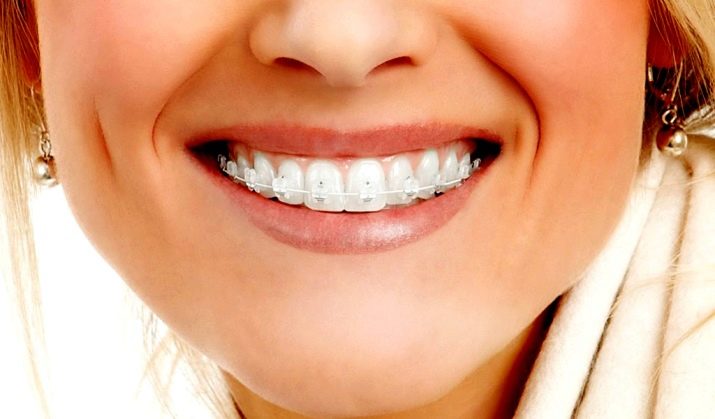How to clean and care for teeth with braces?
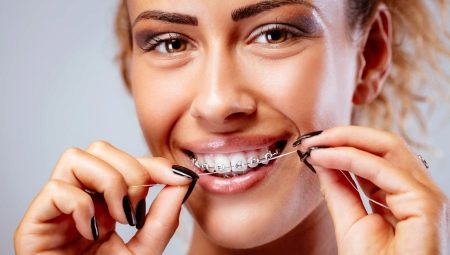
The need to learn how to care for teeth with a bracket system arises for those who first encounter its installation. Corrective orthodontic appliances require a special approach in everything - from the choice of toothpaste to the use of aids. It is worth talking in more detail about how often and how thoroughly you can brush your teeth with braces.
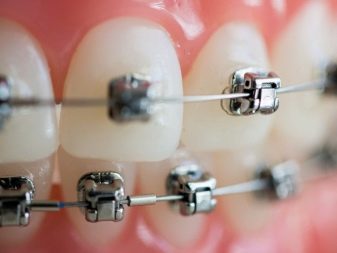

Which toothpaste is right?
More bacteria settle on teeth with braces than under normal conditions. Accordingly, you also need to take care of them correctly. The choice of toothpaste is included in the list of preparatory procedures required by each owner of such systems.
Since conventional cleaning compounds can contain harsh bleaching agents, abrasive particles that are too large, they should be replaced with a more suitable one.
The paste must meet certain criteria.
- Narrow specialization. For cleaning teeth with braces, specially marked products are produced.
- Effective cleansing. For this, abrasive particles based on silicon dioxide are used.
- Fight against pathogenic microflora. The correct pastes have a pronounced antibacterial effect that lasts for a long time.
- Caries protection. Teeth cleaners with braces must be effective against enamel lesions. The main component is fluoride, but their content should be low so as not to affect the adhesive ability of the bracket system.


Both braces with elastic bands and conventional systems without additional tightening components need effective cleaning.
A special toothpaste for them most often contains special components that foaming easily and then destroying plaque. In addition, it is necessary to change the remedy in the process of bite correction.
At the initial stage, it is worth choosing pastes with a high calcium content, then, after 1-2 months, switch to formulations enriched with fluorine. At the final stage of treatment, anti-inflammatory drugs with extracts of medicinal plants are used.
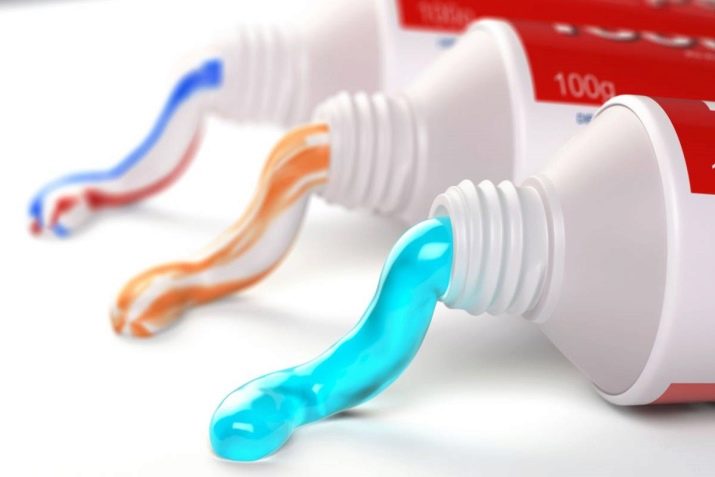
Among the pastes that are suitable for braces, there are some.
- R. O. C. S. Brackets & Ortho. The composition does not contain particles traumatizing the enamel, includes special enzymes and cleaning granules. The composition contains calcium phosphate.
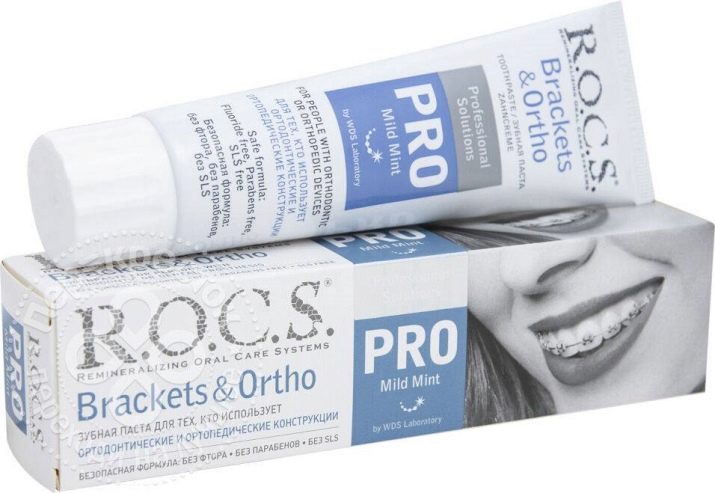
- Curasept. Specialized paste with chlorhexidine content. The tool effectively removes plaque, normalizes the balance of microflora in the oral cavity. The paste does not affect the enamel shade, taste. The composition contains abrasive particles.

- Pierrot Natural Freshness. Anti-inflammatory paste that effectively suppresses the development of bacterial microflora. The composition contains fluorine, allantoin.
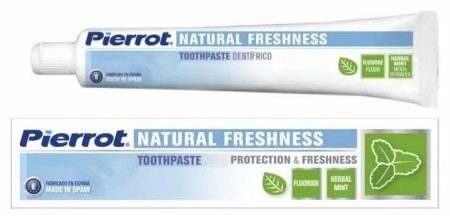
A high-quality toothpaste for the care of various types of braces cannot be cheap. An increased price has to be paid for a more thorough and delicate cleaning, as well as for an effective fight against caries under the orthodontic appliances.


We use items for oral hygiene
Cleaning your teeth at home while wearing braces requires the use of a whole range of special tools. People who have planned to maintain a standardized approach to dental care are often surprised at how difficult regular brushing becomes during this period.
An individualized orthodontic system requires very careful removal of food debris after meals.
In addition, the structures themselves are almost impossible to properly clean without the use of brushes, floss and irrigators.
Orthodontic brush
For regular cleaning of teeth with braces installed on them, it is better to use specialized products. It will be correct to purchase an orthodontic brush that differs from the usual one by the presence of a V-shaped gap between the main rows of beams. The lateral setae are increased in length, while the central setae are shorter. This allows you to successfully clean both the teeth themselves and the metal "bracket" located on top of them.


Ershik
A special brush - a thin base with bristles arranged in a circle, is passed into the gaps between the arches and tooth enamel. This tool is absolutely irreplaceable when you need to take care of oral hygiene while traveling or at home. Brushes are produced in a wide range of sizes, from 2 mm in diameter, can be used with additional handles-holders.

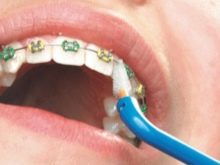

Single-beam brush
This type is also called monofilament, due to the peculiarities of the arrangement of the bristles. They are collected in a local round-shaped block. With such a beam, it is convenient to clean plaque and dirt from the space between the teeth, to process each incisor, capturing the space under the braces. The service life of a single-beam brush is no more than 3 months. You can find such models from most popular brands.
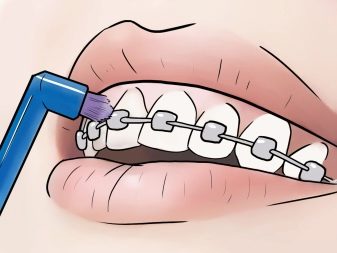
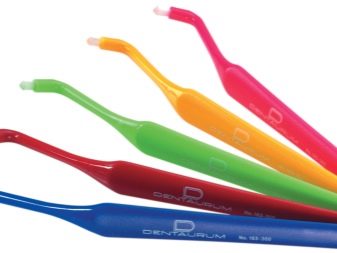
Dental floss
Where the brush turns out to be too rough a tool, floss is used. It provides a thorough cleaning of the interdental space. The use of dental floss prevents the development of contact caries. It helps fight plaque where deposits are difficult to visually notice.
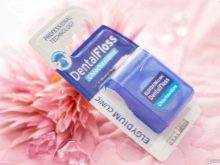
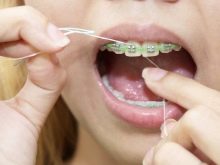

Irrigator
Washing out food debris, carried out by irrigating the enamel surface and the entire oral cavity, can significantly increase the level of hygiene. Irrigators can be used with special additives in the form of herbal infusion, which enhance the effectiveness of the procedure. The pressurized water helps to flush out food particles. Processing is done after eating, for at least 2 minutes.

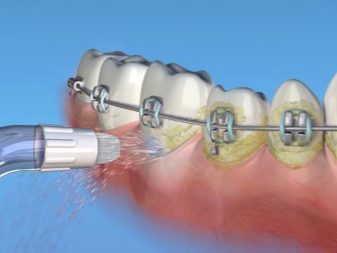
Additional means for cleaning teeth
In addition to the paste during the period of wearing braces, you should pay attention to other caring compositions. They are available in the form of gels and foams designed for express mouth cleansing.
Such products have a chemical effect on bacterial plaque, effectively breaking it down even without using a brush.
It is also recommended to supplement hygienic care with antiseptic rinses - concentrated or ready-made.

How does a professional cleaning work?
This method of care is used when wearing braces at least once a quarter. The dentist removes plaque from the attachment area of the locks of the orthodontic structure. This allows you to remove plaque that cannot be removed at home. If you do not attend a professional cleaning procedure, the accumulated dirt will gradually turn into tartar.
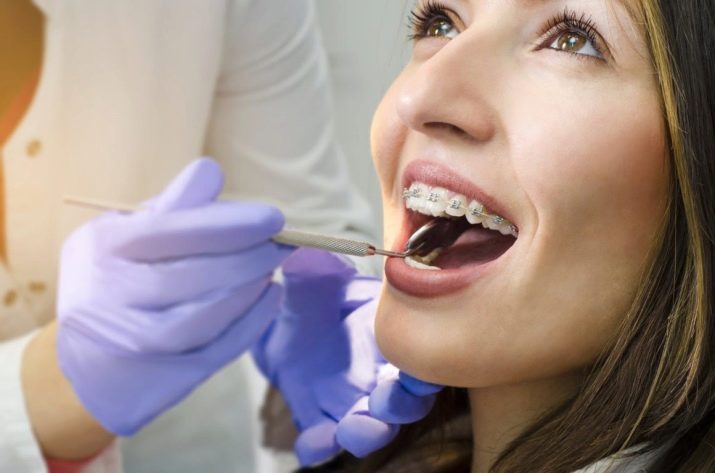
During the treatment of the bracket system with a specialized dental instrument, it is possible to successfully solve many problems.
- Eliminate the formed tartar. It causes inflammation and can lead to numerous oral health problems.
- Polish the enamel of the teeth to a shine. Professional cleaning gives it a healthy and attractive appearance, flawless smoothness.
- Eliminate traces of enamel staining. Even if all the recommendations are followed, dark spots may appear on the surface of the teeth while wearing braces. You cannot get rid of them without bleaching or abrasive pastes. The problem is solved by professional cleaning.
- Protect plates from corrosion. The cleaner they are, the less damage will be done to the surface of the teeth. Contaminated orthodontic appliances become a gateway for caries formation.
- Freshen your breath. Maintaining good hygiene with braces is harder than it sounds. In order to maintain a normal microflora in the oral cavity, periodic professional treatment is necessary.
Exposure to the surface of the bracket system of specialized medical devices makes it possible to avoid their damage, helps to significantly reduce the risk of caries and tartar formation.
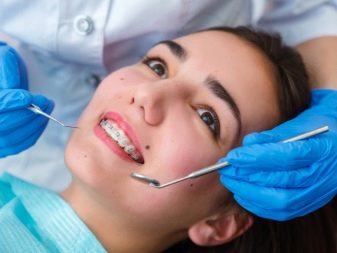
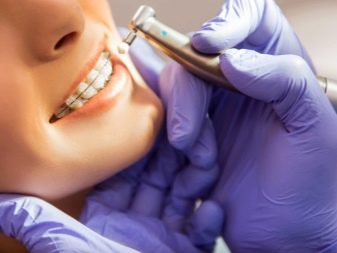
How often should you brush your teeth?
When brushing teeth with braces, the frequency of the procedure changes slightly. It is strictly forbidden to neglect hygiene. Cleaning is done after each meal, as well as in the morning (immediately after waking up) and in the evening before bedtime. On average, the frequency of using the brush reaches 4-5 times a day. In addition, in the absence of access to mechanical cleaning, it is necessary to use rinses and foams that replace it.
It is necessary to proceed to cleansing the braces no later than 10-15 minutes after the end of the meal. Neglect of this rule will lead to the formation of pathogenic microflora in the oral cavity. An unpleasant odor will appear.
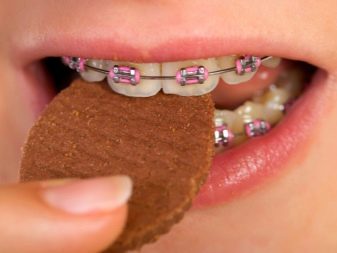
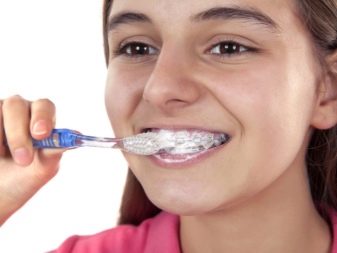
It is important to follow the correct procedure for proper oral hygiene.
- Use an orthodontic brush and paste to superficially clean the enamel of the teeth. At first, the movements are carried out with the perpendicular position of the bristles. They are then angled to clean the base of the braces.
- Use a monobunched brush to clean the gingival pockets. The space under the arc is also processed.
- Rinse your mouth with an antibacterial agent.
- Floss the interdental spaces. Floss will help remove stuck food debris.
- With a brush, work out the areas around the plates and at their base. The arcs must be cleaned very thoroughly.
- Irrigate the oral cavity with an irrigator, reaching the most difficult-to-reach areas.
- Repeat rinsing.
This order should be followed strictly.Neglect of hygiene can very quickly lead to the development of caries under the plates.
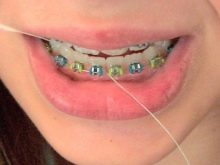
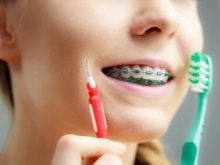

Recommendations
Taking care of your oral cavity after braces are installed can be a rewarding experience for those who care about dental health. It is important to remember that ordinary brushes cannot be used together with arcs and plates - they can damage locks or ligatures. Electrical models without a special mark "for orthodontic structures" are also prohibited.
While wearing braces, you should not experiment with home bleaching, use baking soda or activated charcoal for bleaching.
There are other helpful guidelines as well.
- Duration of hygiene procedures. It should be at least 6 minutes - this is how much is needed for a thorough cleaning.
- Application of the full range of products. Do not neglect the recommendations of the dentist. When cleaning, be sure to use a brush and floss, and if it is not possible to carry out the entire complex of hygienic procedures, perform processing with special gels or foams.
- Compliance with food rules. When using braces, do not eat nuts, sunflower seeds, or candy. Also banned are ice cream, chewing gum, hard vegetables and fruits. Food should be warm - no sharp thermal contrast.
- Cleansing all surfaces of the teeth. It is necessary to carefully remove plaque not only from the front surface of the dentition. Its sides and backs also need careful removal of dirt.
- Scheduled dentist visit. Usually for this, an interval of 2-3 weeks is set. Much depends on the type of braces and other factors. If you experience discomfort or symptoms, you must make an unscheduled visit to the doctor's office.
- Formation of a new piece of thread at each stage of cleaning. This will avoid the transfer of plaque into the oral cavity. If there are signs of bleeding gums, rinse the mouth with clean water.
By following all the rules, you can easily ensure that proper oral hygiene is maintained throughout the entire period of wearing the bracket system.
